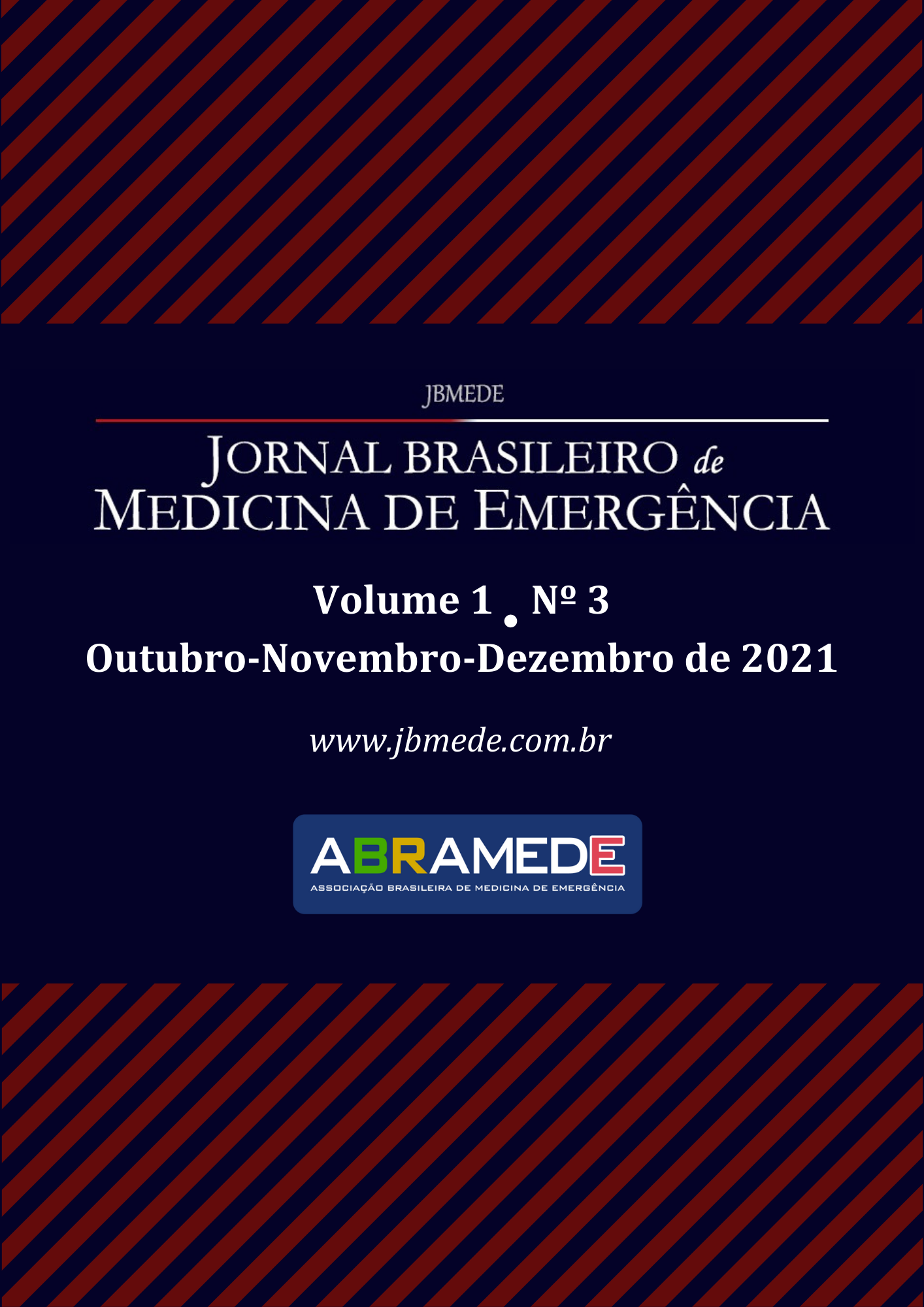PALLIATIVE EXTUBATION: FROM CONCEPT TO MANAGEMENT: AN INTEGRATIVE REVIEW
Main Article Content
Abstract
Palliative care involves the approach and assistance mediated by a multidisciplinary team, aiming to improve the quality of life of the patient and family, in the face of a disease that threatens the continuity of life, through the prevention and relief of suffering, in addition to early identification , correct assessment and treatment of pain and other physical, biopsychosocial and spiritual symptoms experienced by individuals who deal with limiting comorbidities. In this context, palliative extubation, in other words the withdrawal of invasive mechanical ventilation, is still a practice scarcely performed in Brazilian services. The objective of the present study is to bring an integrative review about the concept, bioethical and legal aspects, indications, communication with the patient and family, as well as its management in clinical practice.
Article Details

This work is licensed under a Creative Commons Attribution 4.0 International License.
References
Kostakou E, Rovina N, Kyriakopoulou M, Koulouris NG, Koutsoukou A. Critically ill cancer patient in intensive care unit: issues that arise. J Crit Care [Internet]. 2014 [citado em 09 mar 2021]; 29(5):817-22. Disponível em: https://www.sciencedirect.com/science/article/pii/S0883944114001452. DOI: https://doi.org/10.1016/j.jcrc.2014.04.007.
World Health Organization. National cancer control programmes: policies and managerial guidelines – 2nd ed. Genève: WHO; 2012.
Floriani CA, Scharamm FR. Casas para os que morrem: a história do desenvolvimento dos hospices modernos. Hist. cienc. saude-Manguinhos [online]. 2010, vol.17, suppl.1, pp.165-180. ISSN 0104-5970. http://dx.doi.org/10.1590/S0104-59702010000500010.
Agência Nacional de Vigilância Sanitária (Brasil). Portaria nº. 19, de 03 de janeiro de 2002. Institui no âmbito do Sistema Único de Saúde, o Programa Nacional de Assistência à Dor e Cuidados Paliativos. Diário Oficial da União 03 de jan 2002. Disponível em: http://bvsms.saude.gov.br/bvs/saudelegis/gm/2002/prt0019_03_01_2002.html
Gomes ALZ, Othero MB. Cuidados paliativos. Estud Av. 2016, 30(88):155-166. Disponível em: http://www.scielo.br/pdf/ea/v30n88/0103-4014-ea-30-88-0155.pdf. DOI: DOI: 10.1590/S0103-40142016.30880011.
Grandhige AP, Timmer M, O'Neill MJ, Binney ZO, Quest TE. Respiratory therapists’ experiences and attitudes regarding terminal extubations and end-of-life care. Respir Care [Internet]. 2016; 61(7):891-6. Disponível em: https://www.ncbi.nlm.nih.gov/pubmed/27274094. DOI: doi: 10.4187/respcare.04168.
Araujo MMT, Silva MJP. O conhecimento de estratégias de comunicação no atendimento à dimensão emocional em cuidados paliativos. Texto & Contexto Enferm. [Internet]. 2012; 21(1): 121-9. Disponível em: http://www.scielo.br/pdf/tce/v21n1/a14v21n1.pdf
Kok VC. Compassionate extubation for a peaceful death in the setting of a community hospital: a case-series study. Clin Interv Aging [Internet]. 2015]; 10:679-85. Disponível em: https://www.ncbi.nlm.nih.gov/pmc/articles/PMC4396346/. DOI: 10.2147/CIA.S82760
Hinkle LJ, Bosslet GT, Torke AM. Factors associated with family satisfaction with end-of-life care in the ICU. Chest. 2015; 147(1):82-93. Disponível em: https://www.ncbi.nlm.nih.gov/pubmed/25103451. DOI: 10.1378/chest.
Brush DR, Rasinski KA, Hall JB, Alexander GC. Recommendations to limit life support: a national survey of critical care physicians. Am J Respir Crit Care Med. [Internet]. 2012; 186(7):633-9. Disponível em: https://www.ncbi.nlm.nih.gov/pubmed/22837382. DOI: 10.1164/rccm.201202-0354OC
Chang SY, Sevransky J, Martin GS. Protocol in the management of critical illness. Crit Care [Internet]. 2012; 16(2):306. Disponível em: https://www.ncbi.nlm.nih.gov/pmc/articles/PMC3584719.
Andrade CG, Costa SFG, Lopes MEL. Cuidados paliativos: a comunicação como estratégia de cuidado para o paciente em fase terminal. Ciên Saúde Colet [Internet]. 2013; 18(9):2523-30. Disponível em: http://www.scielo.br/pdf/csc/v18n9/v18n9a06.pdf.
Kim DJ, Choi MS. Life-sustaining treatment and palliative care in patients with liver cirrhosis - legal, ethical, and practical issues. Clin Mol Hepatol. 2017 Jun; 23(2): 115–122. doi: 10.3350/cmh.2017.0018.
Macchi MJ, Peréz MV, Alonso JP. Planificación de los cuidados en el final de la vida. Perspectivas de profesionales de oncología y cuidados paliativos. 2020 Aug; 35:218-36. https://doi.org/10.1590/1984-6487.sess.2020.35.11.a
Lobo SM, de Simoni FHB, Jakob SM, Estella A, Vadi S, Bluethgen A et al. Decision-making on witholding or withdrawing life support in the UCI: a worldwide perspective. Chest 2017; 152(2):321-9. https://doi.org/10.1016/j.chest.2017.04.176
Victor GHGG. Cuidados paliativos no mundo. Revista Brasileira de Cancerologia 2016; 62(3): 267-270.
Conselho Federal de Medicina. RESOLUÇÃO CFM Nº 1.805, DE 9 DE NOVEMBRO DE 2006. Diário Oficial da União; Poder Executivo, Brasília, DF, n.227, 28 nov. 2006. Seção 1, p.169.
Kelley AS, Morrison RS. Palliative care for seriously ill. N Engl J Med 2015; 373:747-755. DOI: 10.1056/NEJMra1404684.
Murray SA, Kendall M, Mitchell G, Moine S, Amblàs-Novellas J, Boyd K. Palliative care from diagnosis to death. BMJ 2017;356:j878. doi: https://doi.org/10.1136/bmj.j878
Cook D, Rocker G. Dying with dignity in the Intensive Care Unit. N Engl J Med 2014; 370:2506-2514. DOI: 10.1056/NEJMra1208795.
de Carvalho RT, Parsons HA. Manual de Cuidados Paliativos ANCP. 2ª ed. São Paulo, 2012.
Kon AA. The shared decision-making continuum. JAMA. 2010;304(8):903-904. doi:10.1001/jama.2010.1208.
Coradazzi AL, Inhaia CLS, Santana MTEA, Sala AD, Ricardo CP, Suadicani CO et al. Palliative withdrawal ventilation: why, when and how to do it? Hos Pal Med Int Jnl. 2019;3(1):10‒14. DOI: 10.15406/hpmij.2019.03.00141.
Lundquist G, Rasmussen BH, Axelsson B. Information of imminent death or not: does it make a difference? J Clin Oncol. 2011; 29(29): 3927-393. DOI: 10.1200/JCO.2011.34.6247.
McCabe MS, Storm C. When doctors and patients disagree about medical futility. J Oncol Pract. 2008 Jul; 4(4): 207–209. doi: 10.1200/JOP.0848503
Puchalski CM. Spirituality in the cancer trajectory. Ann Oncol. 2012; 23(s3):iii49-55. https://doi.org/10.1093/annonc/mds088
Sinclair S, Beamer K, Hack TF, McClement S, Bouchal SR, Chochinov HM et al. Sympathy, empathy, and compassion: a grounded theory study of palliative care patients’ understandings, experiences and preferences. Palliat Med. 2017 May;31(5):437-447. doi: 10.1177/0269216316663499.
O’Mahony S, McHugh M, Zallman L, Selwyn P. Ventilator withdrawal: procedures and outcomes. Report of a collaboration between a critical care division and a palliative care service. J Pain Symptom Manage. 2003 Oct;26(4):954-61. doi: 10.1016/s0885-3924(03)00333-6.
Kompanje EPO, van der Hoven B, Bakker J. Anticipation of distress after discontinuation of mechanical ventilation in the ICU and the end of live. Intensive Care Med. 2008 Sep;34(9):1593-9. doi: 10.1007/s00134-008-1172-y.
Coelho CBT, Yankaskas JR. Novos conceitos em cuidados paliativos na unidade de terapia intensiva. Rev Bras Ter Intensiva. 2017;29(2):222-230.
Truog RD, Brock DW, White DB. Should patients receive general anesthesia prior to extubation at the end of life? Crit Care Med. 2012 Feb;40(2):631-3. doi: 10.1097/CCM.0b013e3182413b8a.
Domenico BG, Claudia G, Monika O, Ralf J. COVID-19: decision making and palliative care. Swiss Med Wkly. 2020;150:w20233. DOI: https://doi.org/10.4414/smw.2020.20233

